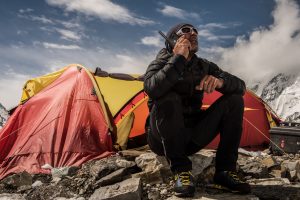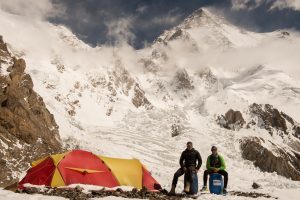Case Study: Speedcast Brings Global Viewers on an Incredible Journey with Renowned Explorer Mike Horn
Story Highlights
According to the history books, Europeans began exploring the globe starting in the 15th Century. It was called the Age of Exploration, and it came to an end more than 200 years ago. Mike Horn never got that memo.
Born in South Africa and living in Switzerland, Mike is probably the world’s most famous explorer alive today. He swam the length of the Amazon solo, circled the world along the equator without benefit of a motor, and completed an unsupported crossing of Antarctica at its greatest length. Starting in 2016, he began the Pole2Pole expedition, a circumnavigation of the globe that ends in 2019 and includes an attempt at the K2 summit and the crossing of the Arctic Ocean via the North Pole.
The explorers of old went in search of glory and riches. Mike has a different mission. He believes that, if he can show enough people firsthand the rapid environmental changes sweeping the globe, we can better understand the impact of climate change and begin caring enough to take action.
A mission like that requires impact. For the Pole2Pole expedition, Mike sought to share his journey in real time with a global audience, trusting that the immediacy and drama of his message would achieve more than he had achieved before. That led him to Speedcast, the world’s largest provider of remote communications and IT services, which agreed to become a contributor to his mission. It was to be a partnership that put both to the test.

Communicating to base camp about weather conditions, including snowfalls and avalanches, required reliable connectivity. Courtesy of Dmitry Sharomov
The Challenge
The biggest challenges to Mike’s vision of real-time reporting was connectivity. Places like the 8,611-meter K2 and the Arctic are not just off the grid – you can’t even see the grid from there.
Connectivity was also about more than telling a story and streaming video online. With reliable internet connectivity came the ability to check weather conditions, snowfall and avalanche risk to ensure the safety of the team. It transformed navigation from dead reckoning to the precision of GPS and digital maps. For the family and friends that the team left behind, it was a way to keep in touch throughout the journey.
The Solution
Speedcast staff would not be on the road with Mike, but the intensive preparation they put into the communications plan made them a key part of his team. Mike needed continuous broadband access with occasional live video streaming and the sharing of high-quality photos and video clips, which would surge the bandwidth requirements. Real-time communications required minimal delays in transmission. The communications equipment needed to be light, modular and capable of operating at high altitude and extreme temperatures. Power would come from batteries, which would be recharged by portable solar panels and generators.
Speedcast provided the team with satellite communication devices including handhelds, portal antennas, and Speedcast FieldVision, a unique tracking solution that could precisely monitor Mike’s location at all times. Behind the devices stood Speedcast Atlas, a fully-managed, end-to-end service delivered over a global network of satellites, teleports, optical fiber, and cellular networks. It offers borderless coverage in any weather conditions. Monitored and managed 24x7x365 by a team of skilled technicians, Speedcast Atlas is designed for communications that must not fail.
The Ascent of K2
K2 was more than a mountain for Mike. It was a mission. He had made two previous attempts in 2010 and 2015 and was still determined to conquer the summit. For the 2019 ascent, Mike and his team set up two camps along the trek to the summit to support the climb. Using a long-established base camp at 5,200 meters (17,060 ft.) in altitude as their home base, they carried and dropped off equipment, including the modular communications gear and power supplies, at each of the camps.

Mike set up several base camps on his journey to the K2 summit, so it was critical to have modular, lightweight and easy-to-carry communications equipment. Courtesy of Dmitry Sharomov
The day of his arrival at K2, Mike witnessed one of the biggest avalanches he had ever seen, whose powder cloud climbed to 6,500 meters (21,325 ft.). It was a dramatic sign of the dangers that lay ahead.
After a month of acclimatization, Mike began waiting for a break in the weather that would make a push for the summit possible. He and Fred Roux, a Swiss alpine guide and close friend, planned to travel light and move fast, climbing without oxygen tanks, stopping at the camps along the way to refresh and recharge their batteries.
Even in July, when Mike and Fred set off, conditions on K2 are harsh. Temperatures at the summit range from -15 to -65 degrees C (5 to -85 F). Wind speeds rise to 80 kph (50 mph) or higher. Of the five highest mountains in the world, K2 is the deadliest, where about one person dies on the mountain for every four who reach the summit. When Mike and Fred set off, they were the only one of 120 teams at the base camp to attempt the climb during a brief break in bad weather.
They left K2 base camp, 5,200 meters (17,060 ft.) in altitude, at 4 am on July 15. They reached Camp 2 at 6,400 meters (21,000 ft.) and rested briefly, then headed for Camp 3 at 7,200 meters (23,700 ft.), still 1,400 vertical meters (4,600 ft.) from their goal.
At 6pm on July 16, after another short rest, they began the final push to the summit. At around 1 am, strong winds, heavy snow drifts and lack of oxygen began to put their lives at serious risk, and the explorers decided to turn back. After an arduous climb down, they reached base camp as bad weather closed in again, with minor frostbite on faces and feet.
Despite his disappointment, Mike called the 2019 K2 ascent “one of the greatest climbs in alpine style in my life.” With the rest of the Pole2Pole adventure waiting, Mike reluctantly had to leave the ascent of K2 to another day.
Mission Accomplished
The brutal conditions on the way to the top of K2 may have stopped Mike and Fred this time, but they could not stop the communications gear or network that supported Mike’s most important mission. Through the Speedcast network, nearly 600,000 people followed their adventure in real-time on social media, and 15.5 million were exposed to highlights of the perilous climb. Never before had Mike reached so many with the impact of real-time photos and live video streaming. That audience was primed to follow the Artic crossing that would bring the Pole2Pole expedition to a triumphant close.
Join the adventure at Speedcast’s website, Instagram page, or Facebook.
